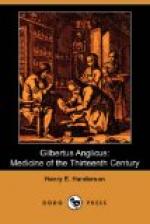If the color of the affected part is red, it indicates that the materies morbi is sanguineous; if greenish-yellow (citrinus), that it is bilious; if whiter than the general color of the body, that the materies is a subtile phlegm. If the color shades away into black, it does not signify necessarily that the materies is simply black bile, for such a color occurs at the close of acute abscesses, or from strangulation of the blood. But if, together with the black color, we find the tissues cold and no increase of heat in the affected part, this indicates that the materies is black bile.
By touching the diseased part we determine its heat or coldness, hardness or softness, roughness or smoothness, fullness, distention or evacuation, all of which signs possess special significance.
The antecedent causes of gout, Gilbert tells us, are a heat too solvent, cold too constringent (f. 311 c), sometimes a strong bath or a severe journey in a plethoric person (in plectorico), again excessive coitus after a full meal (satietatem), or even habitual excess, by which the joints are weakened and deprived of their natural heat and subtile moisture. Hence boys and eunuchs are not commonly affected by gout—at least boys under the age of puberty. Women, too, do not usually suffer from this disease, because in coitus they are passive, unless their menstrual discharge is suspended. Again gout sometimes arises from infection of the primary semen; for a chronic disease may be inherited by the offspring and affect the material causes, i.e., the humors. Flatulence (ventositas) is likewise a cause of gout, as we have already hinted.
In gout of the sanguineous type the favorite remedy of Gilbert was venesection, pushed to extremes which suggest the bloody theories of his later confrere Bouillaud. This bloodletting, however, was always to be practiced on the side opposite to that affected by the disease, as he tells us, for two reasons: First to solicit the peccant material to the opposite side; and, second, to retard its course toward the seat of the swelling. If, therefore, the disease is in the right foot, he bleeds from the basilic vein, or some of its branches, in the right hand. No other vein should be taken, but if neither the basilic vein nor one of its branches can be found, the bleeding may be performed upon the median vein, for certain branches of the basilic and cephalic veins unite to form the median. If the disease is in the hand, the material may be diverted in two ways, either to the other hand or to the opposite foot. Indeed, blood may be taken from both these parts in succession. The quantity of blood withdrawn should be in accordance with the strength of the patient, the character of the swelling, the pulsation, distention, heat and redness of the affected part. But it should be repeated frequently, and this bloodletting then frequently suffices, in itself, to cure the disease.




